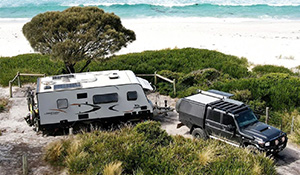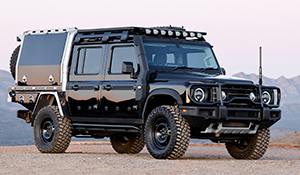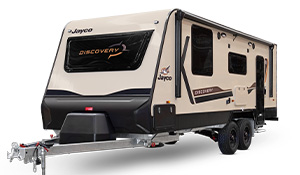TECH – Fering Pioneer
Photos: Fering
Brought to you by Castrol EDGE
What sort of vehicle do adventurers, explorers and emergency services want for extreme environments? If British company Fering have read the market correctly, it’s their ‘Pioneer’, a lightweight, long range, four-wheel drive ute with all the capabilities of a diesel-powered 4x4, but offering less complexity and a lot less pollution.

The Pioneer is the brainchild of ex-Ferrari and McLaren engineer Ben Scott-Geddes, who has taken what he’s learnt with cutting edge supercar and racing technologies to create a vehicle that combines environmental responsibility with what he claims are unrivalled off-the-grid capabilities.
Scott-Geddes leads a team at Fering that includes designers, engineers and fabricators with experience across the automotive industry - from compact city EVs to military vehicles and premium supercars – as well as the aeronautical and marine industries.
The team also includes Mac McKenney, who has planned, trained, equipped and undertaken various automotive expeditions in hostile and remote environments around the world for more than 25 years.

Little, but Strong
Underpinning the Fering Pioneer is a lightweight aluminium spaceframe chassis with a compact footprint that’s no larger than a car-based delivery van and no heavier than a modern hatchback. Composite materials integrated into the aluminium spaceframe help keep the off-road ute down to around 1,500kg, but a greater contribution is made by the use of fabric coverings for several external panels. Such an approach was taken with ‘light cars’ a century ago and was also seen on some post-war invalid cars and microcars.
For the Pioneer, the fabric chosen is a canvas found in sails and high-end hiking boots. Its advantages, beyond reducing the vehicle’s weight, include being easy to replace and offering better in-vehicle insulation properties than conventional metal-skinned panels, according to Fering.
“We are planning on expanding the use of fabric to other parts of the vehicle, such as the inner wings, where we are sure it will have excellent noise insulation properties in addition to saving weight and complexity,” Scott-Geddes says.
The construction of the spaceframe, its light overall weight and the configuration of the Pioneer’s suspension means it can carry its own weight – 1,500kg - making it valuable for hauling firefighting apparatus into remote locations, medical equipment and/or patients following off-road accidents, mining gear and tools underground, explorers and expedition equipment or even a small squad of soldiers, as military use could be another application for the Pioneer.

Ready for the Rough
Along with the aforementioned features, off-road capability comes from the use of large - 22.5-inch - wheels that are designed to take commonly-available truck tyres, ensuring replacements are more likely to be found, even in remote areas.
As truck tyres are usually of thicker wall construction, it makes them more durable for the kinds of extreme environments the Pioneer is likely to be used in, while the light weight of the Pioneer means they’re subjected to less stress. Additionally, as truck tyres are often recapped, it reduces tyre waste, furthering the Pioneer’s green credentials.

The narrow cross section of truck tyres may be seen as a disadvantage off-road, but according to Scott-Geddes, that’s not the case.
“To get a big patch of rubber in contact with the ground, you can either have wide tyres, or have them tall, but narrower,” Scott-Geddes explains. “The latter option gives big benefits in off-road situations and makes the contact patch longitudinal.”
While the Pioneer’s tyres will be commonly available, the wheels are custom made and unique to the vehicle, designed to offset the weight of the tyres to some degree, as well as being resistant to damage, simple to remove and easy to clean.

Specifications for the Pioneer’s suspension and brakes haven’t been revealed, other than to say the former is “sophisticated” and offers a lot of travel, with the latter mounted inboard on both the front and rear axles.
For all its practical touches, the Pioneer has one element that seems like a pure design feature in the form of a Union Jack that’s moulded into the ute’s tailgate. However, Fering says even this is functional, as the stampings to create the flag motif serve as strengthening ribs.

EV and Clean Fuel
The Pioneer comes with four-wheel drive as standard, with both axles driven by electric motors. The type and capacity of these motors hasn’t been revealed, but Fering say they are “Best in Class” and produce a combined 800Nm of torque, which exceeds that of many diesel-powered 4x4s.
The drivetrain configuration allows either one of the driven axles to be deactivated in less demanding environments, while mounting the motors inboard ensures good wheel clearance in boggy conditions and over loose surfaces.
Instead of Lithium Ion cells, the supporting battery pack uses Lithium Titanate Oxide cells that are less susceptible to extremes in temperature and don’t degrade with repeated power cycling like some batteries do.

The battery allows for a claimed range of around 80km, but recognising the impracticality of this for long expeditions and other applications in off-the-grid environments, there’s a range extender in the form of an 800c three-cylinder internal combustion engine.
Like the electric motors and battery, the origins of the three-cylinder engine are unknown, but it’s likely from a production ATV of some type, with Kubota and Perkins producing engines in this capacity and configuration.

Fuelled by biodiesel to reduce emissions and improve efficiency, the 800cc triple is only used to charge the battery, not drive the wheels. With this engine in place, range extends to a claimed 7,000km with long-range tanks fitted. For applications where such range isn’t needed, the auxiliary tanks can be replaced with freshwater tanks or additional equipment.
Fuel economy is said to be exceptional, with the claimed 50mpg being around double the mileage of conventional diesel 4x4s, according to Fering, and closer to what you’d find in a modern diesel-engined hatchback.
The standard drivetrain can be replaced with alternatives, reflecting what the vehicle’s application might be or the fuels available in that area, like alcohol-fuelled engines in Brazil, for example. Fering says larger batteries can be incorporated into the Pioneer’s modular design, too.

Phase 2 Begins
In December, Fering announced that, following extensive testing of their ‘Prototype 1’ development ute at the UK’s Milbrook Proving Ground, two more prototypes will be produced in 2023, using what’s been learned on the original to incorporate upgrades.
“Driving over the obstacles showed the very good natural ability of the Pioneer in severe off-road conditions,” Scott-Geddes explains. “It was able to traverse all the physical standard obstacles we tried without any issue, including those intended to challenge much larger and extreme military vehicles.
“The off-road capability is exceptional, proving our design philosophy of low overall weight, large diameter tyres and long wheel travel works brilliantly.”
Key to moving forward with Prototype 2 and Prototype 3 has been securing funding, which Fering credits to demonstrations of the Pioneer they’ve conducted to show its capabilities.
Customers have been confirmed, too, and while they are organisations, not individuals, Fering has not confirmed who those organisations are.
Fering’s next batch of prototype testing with the Pioneer EV 4x4 is due to be completed in mid-2023, with low-volume production to commence later in the same year, ahead of large-scale production in 2025.









